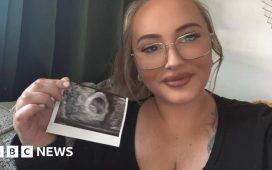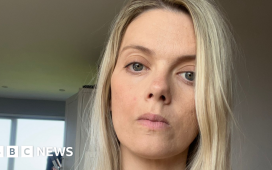A cancer patient who was told as a teenager her cancer was ‘too rare to return’ died of the illness 18 years later after it came back.
Laura Ricaud was 13 when she was diagnosed with adamantinoma, a rare type of cancer that typically develops in the shinbone, in 2005.
She was told she was cancer free in 2007, following a surgery which removed the biggest part of her shin and replaced it with her left fibula.
But in 2020 she found out the cancer had returned.
Laura, originally from France, had moved to England to study and was given the crushing diagnosis after running a half marathon in Leeds.
She’d been experiencing chest pain for several months, and was told cancerous nodules were visible on her lungs.
A biopsy revealed it was in fact the same cancer she’d been diagnosed with previously – and it was incurable.
Laura said: ‘My future, my hopes, my dreams were gone as quick as the snap of Thanos’ fingers in Avengers.
‘The little discomfort I had been feeling was actually something that was slowly killing me.’
Laura returned to France in 2020 to seek a second opinion and be closer to her family.
She said: ‘Ironically, the beginning of my treatment coincided with beginning of the first lockdown in France.
‘I took it as a sign that the universe was slowing down its course so I could follow the rhythm.’
Laura’s health deteriorated quickly, and while she could have tried further chemotherapy, its effectiveness was unknown.
Laura tragically died on January 24 this year, aged 30, three years after her second adamantinoma diagnosis and 18 years after her initial diagnosis as a teen.
After her death her partner Loic found the story she’d been writing to document her journey on her computer.
He said: ‘Laura told me that adamantinoma is a cancer that mostly attacks children, and she found that incredibly unfair.
‘She wanted to raise awareness of this rare disease and said: if my story can contribute to something, even if I am no longer here, I need to do it.’
Laura wrote her story in January, as her situation became ‘more and more complicated and critical’.
She said: ‘I am now in a race against time. If this is not an effective treatment, I may not be here to see 2024. I went from being shocked to just accepting it.
For the past few months, I have spent my days on the sofa, around a kingdom of pillows and cushions because the slightest effort is extremely hard.
‘I am out of breath easily and in pain. I have lost a lot of weight, my muscles have disappeared, and the long nights of good sleep are a distant memory.
‘The situation has changed me drastically. I have worked on myself, I had to find a way to come to terms with things.
‘I learnt the hard way that life is surprising… I have lived through some extremely painful situations, but also some beautiful ones.
‘It’s like there’s no place for fake appearances and everything is shared with violent truth.
‘I have created incredible bonds with my friends and family, even with people that I was not close to before, and with complete strangers.
‘I opened my mind to things I felt curious about in the past, but I never dared to try, things like non-traditional medicine.
‘I mostly learnt to listen to myself.’
What is adamantinoma?
Adamantinoma is a rare form of primary bone cancer that is most commonly found in the shinbone (known as the tibia) that can also affect the fibula (the calf bone).
This cancer accounts for less than 1% of all primary tumours arising in the bone.
It can develop in anyone at any age, but most commonly occurs in the age range of 20-35 years of age.
The spread of the cancer to other areas of the body happens in around 15-20% of patients and can occur many years after the diagnosis and treatment of the primary adamantinoma has taken place.
This July the Bone Cancer Research Trust’s Sarcoma Awareness Month features Laura as the face of its campaign.
She had these photographs taken before her death to be published alongside her story.
The awareness month has been set up to raise awareness of sarcomas, which the charity says have seen little improvements to treatment and survival rates in the last 40 years.
For more information and to seek support, visit the Bone Cancer Research Trust’s website.
Get in touch with our news team by emailing us at webnews@metro.co.uk.
For more stories like this, check our news page.
Get your need-to-know
latest news, feel-good stories, analysis and more
This site is protected by reCAPTCHA and the Google Privacy Policy and Terms of Service apply.












